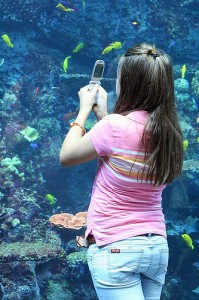One of the most interesting presentations (to me!) that I attended at ASERA was called Observing, recording, and reviewing: Using mobile phones in support of science inquiry, a presentation by Elaine Khoo and John Williams (University of Waikato, NZ), Kathrin Otrel-Cass (Aalborg University, Denmark), Darren Cutler (Cambridge HS, NZ), and Michelle Ballard and Jim Critchley (Mount Maunganui College, NZ). The data presented was collected as a part of a larger research project called Networked Inquiry Learning in Secondary Science Classroom. The description of this research project fascinates me and I’m looking forward to seeing some more of the results. The team aims to “explore what knowledge, skills and attitudes are needed so that inquiry teaching and learning in science can be supported through e-networked environments (i.e. blogs, e-mail), and further to see how online resources can support individual and group explorations in science.” This is exactly the kind of research that I’m interested in and hoping to conduct myself.
Through classroom observations of two science classes over 2-6 weeks the team collected data on how students used mobile phones during classroom science learning activities. Findings depended on the classroom culture around cell phone use. In one class it was part of the established class culture that students could use cell phones to record and share with each other and their teacher. In this class student use of cell phones during laboratory activities was student initiated. Students took videos of their experiments and played them back for each other, asking new questions about the phenomena as they watched the videos.
In a second class the use of cell phones had to be encouraged by the researcher. In this case students used the phones to collect data ‘because they were asked to’ and used the videos to ‘see where they had gone wrong’.
Students also used their cell phones to share what was happening in their science class at home or with their friends, thus mobile phone use in the classroom enabled learning to be extended outside the classroom.
The researchers concluded that mobile phone use in science classrooms can provide multimodal opportunities to voice, capture, share and refine observations and that the mobile phone recordings offered a different dimension to science teaching and learning. I was particularly excited by the stories of students’ spontaneous use of cell phones to capture data and use the evidence to argue a scientific point more persuasively or to share their learnings with parents or peers. If what we are doing in science classrooms is engaging enough, students will do what they do in their personal lives, capture and share experiences, relive them over and over, and ask deeper questions as they continue to engage with the science concepts outside the class time allotted for the experiment.


Sounds like an interesting project to follow. My question would be how do the teachers ensure that the students all have access to cell phones that have the capabilities needed for the capture and share portion of the classes? Are there any issues with students who check their Facebook updates etc on their phones instead of being focused on the video assignment?
Thinking of my now ancient science classes and the labs that were conducted, it would have been very helpful to me and my classmates to be able to video our labs and review them with other classmates in order to complete our lab write-ups. Perhaps the students could conduct a video discussion of the process and results instead of written lab? The collaborative aspect would be easier if the students and could compare their results. Also, the teacher could potentially have access to the videos as data for assessment purposes. Linking these results to a collaborative discussion online would help the teacher to evaluate the level of thinking that the students are achieving with this task.
All great points Nicole, and the project did discuss some of these ideas too…particularly the potential for assessment purposes for teachers. I love the idea of having students discuss their results as part of a video – oral lab reports! This could be one form of assessment, not necessarily to replace the traditional written lab report, that becomes part of the science class culture. To address your first point, I think the challenge that we all have, high school and post secondary instructors, is to make classes engaging enough so that students aren’t too distracted by potential online interactions, since in reality, whether we condone it or not, lots of socializing happens in class, virtually and in person!
Thank you for your interest in our study. To respond to Nicole, it is true teachers cannot expect that all students have cellphones and at times if they do they may not have audio or video recording facilities. However more and more students have smartphones or devices such as ipods that can be used for this purpose. To integrate mobile devices in the classroom work not all students need to have a cellphone, often one is enough in a group of two or three. Integration of m-technology thus implies a response to the teacher’s awareness of the devices that students have access to and are comfortable using. In a different setting we were working with a class who used flip videos, video devices with in-built usb ports that the school made available to their students. Students recorded and reviewed and their teachers were able to use the video for assessment purposes as suggested above. For more read Otrel-Cass, K., Khoo, E., & Cowie, B. (2012). Scaffolding with and through videos: An example of ICT-TPACK. Contemporary Issues in Technology and Teacher Education, 12(4).